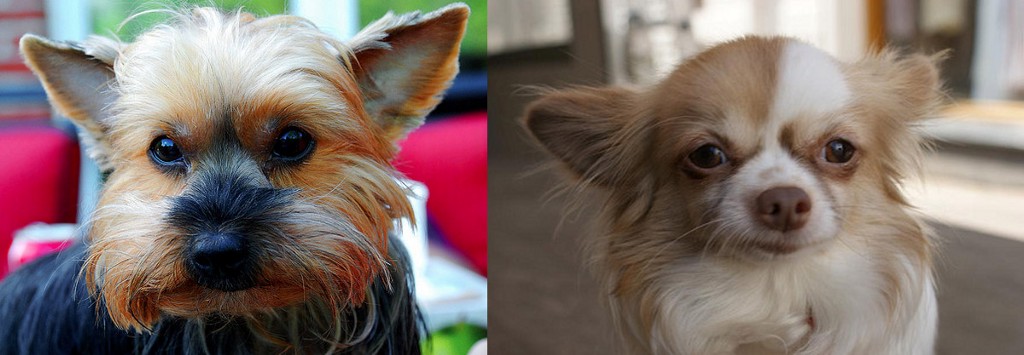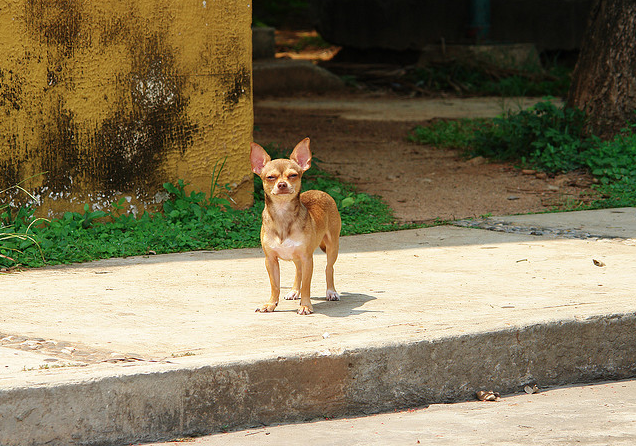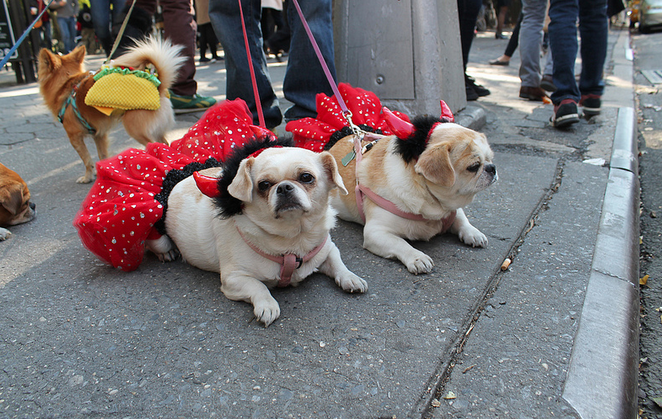New York vs. Los Angeles: Just the Dogs

As the two American population and media centers on opposing coasts, New York City and Los Angeles are prone to endless imperfect comparison. New York has delicious, abundant water, which may or may not make its bagels and pizza so far superior to L.A.’s; in Los Angeles, it is currently in the mid-60s, and will stay that way for the remainder of winter. Now, thanks to the datasets compiled by local radio stations WNYC and KCRW, it is possible to make measure of New York and Los Angeles using a common household pet, the canis lupus familiaris.
First, a note regarding data: The WNYC dog dataset includes 81,542 individuals, pulled from the New York City Department of Health and Mental Hygiene’s dog licensing program list from 2012. Approximately four out of five dogs in New York are unlicensed. The KCRW L.A. dog data offers a similarly incomplete but best-available picture. Pulled from 23 different county and city agencies, as well as the Southeast Area Animal Control Authority, it includes 416,338 individuals. Like New York, many dogs in L.A. are unlicensed, and therefore not included — pit bulls in particular are prone to under-licensing, miscategorization, or misidentification (often willful; people are scared of the very name). Some cities or agencies within L.A. did not respond to requests for data; others limited data due to privacy concerns.1 Both the WNYC and KCRW datasets are similar structured — the KCRW dog project was inspired by WNYC’s — with individuals grouped by name, breed, and zip-code. Other attributes, including sex and coloration, were included but largely ignored in each of the radio stations’ final reports.
How best to parse this data? Our statistical analysis (chi-square for breed and dog names; logistical regression for gender) can be found below. The radio stations arranged individual specimens of canis lupus familiaris by name, breed, and zip code, then displayed the results over maps of the city, so that one is quickly able to ascertain the most prevalent, hyper-regionalized dog specimens. For example, in Malibu, Santa Monica, and Venice Beach, Labrador retrievers2 named Lucy predominate. The same is true on the entire Upper West Side of Manhattan. In fact, the Labrador-heavy neighborhoods in both cities (for the most part particularly affluent — with median household income well-above $85,000/year — and majority caucasian) nearly all favor the name Lucy.3 The similarities do not end there. In both L.A. and NYC, Max4 is the most popular dog name, and Bella5 is the second most popular. But this is not an article about the similarity. No, it is about the difference in New York and Los Angeles canids, and what those differences might tell us about the cities, and their respective cultures and residents. Once the focus shifts, two archetypes emerge.
The Archetypes

The New Yorkie: While New York’s most popular breed is not a breed at all, but “mutts,” attention must be paid to the prevalence of the Yorkie, particularly in the affluent, “cool” “hip” and “tastemaking” neighborhoods of Williamsburg, in Brooklyn, and the Lower East Side, in Manhattan (attention will be paid to the similar “keystone” enclaves of Los Angeles — Silverlake and Echo Park — in the succeeding section).
The Yorkshire Terrier, though initially bred to catch rats in clothing mills,6 rather quickly became a favorite among “families of European high society” according to the American Kennel Club. The breed adapts easily, is self-possessed, sometimes high strung, often quite yappy — and hypoallergenic. Yorkies require more stimulation than most. The AKC posits that this is due to the breed’s grimy, factory roots.
The bustling streets and shoebox apartments of New York make a natural habitat for a Yorkshire terrier. Such environs are perhaps the closest approximation to the rat-infested clothing mills from which the breed sprang. The street-Yorkie is often slightly mixed — as in not purebred, or lacking papers — and can be seen jauntily trotting the sidewalks, appearing athletic, world-weary, and wise. Indoors, the Yorkie may exude calm to the point of uncaring, particularly on subways, or when snuck into offices and waiting rooms. The Yorkie commands attention, but does not demand it. Though it is impossible to confirm, the New Yorkie is probably really embarrassed by Golden Retrievers.

L.A. Chihuahua: The Chihuahua is, by far, the most popular dog breed in the greater Los Angeles area, appearing nearly everywhere except the (affluent, caucasian) labrador strongholds previously described. Great swaths of the region, from San Pedro and Long Beach on north up through Pico Rivera, Hacienda Heights, and La Puente might, for our purposes, be dubbed “Chihuahua Country.” Though Chihuahua Country permeates nearly all parts of the Los Angeles basin as well as many zip codes in the San Fernando Valley.
The most popular name throughout Chihuahua country is Princess. Chihuahuas are also the dominant breed among the hip keystone enclaves of Silverlake and Echo Park, as well as the neighboring Los Feliz, Glassell Park, Atwater Village, and Highland Park. In Los Feliz, which shares demographic traits with labrador country, the most popular dog name is Lucy. In Glassell Park it is Bella. In Echo Park and Silverlake it is Cookie. One member of our expert panel7 cohabitates with a “taco terrier”8 named Cider.
The American Kennel Club begins its Chihuahua breed-report thusly: “Legend and history are rich in tales of the ancestors of the present Chihuahua. He is described as a popular pet, as well as a religious necessity. The Techichi, companion of the ancient Toltecs, is believed to be the progenitor of the Chihuahua.” This is an old, old breed; older than Columbus, who referenced the dog in a letter; older than the Maya; old enough that its size (among the smallest of any canid) might come from the Chinese Crested, brought over from Asia across the Bering Strait when it was still iced over. Anyway, fast forward many thousands of years and you have a desert dog that will shiver if it drops below 70. A real L.A. dog. One owner/panelist described a fleece hoodie used for “chilly” morning or evening walks (“We also have an array of faux fur capes my mother has gotten for her that make her look like Norma Desmond or a dead raccoon,” the panelist noted). Chihuahuas seem to mind dressing up less than most breeds, perhaps because they love burrowing. The temperament of a chihuahua is highly, highly variable. They are loyal to a fault, and look good in sunglasses.
Statistical analysis

By Breed: Chihuahuas, Labrador Retrievers and Lab mixes, Maltese, Pit Bulls, and Shih Tzus were 5 of the 10 most popular breeds in both L.A. and NYC. Of these, we predicted there would be a higher proportion of large breeds in L.A. than NYC. To test this, the proportions of these five dominant breeds were compared between the two locations using a chi-square test.9 We found a significant difference in proportion of breeds from different locations (chi-square = 8465.3, df=4, p<0.001). Certain large breeds were found to be more common in L.A. than NYC. For example, Labradors comprise 9.5% of dogs in L.A. compared to 5.3% in NYC, respectively. However, Chihuahuas made up 15.6% of dog breeds in L.A. and only 4.4% in NYC.10
By Gender: We hypothesized that there would be no preference for male versus female dogs in both cities. While this hypothesis was supported for dog gender preference in L.A. (pmale = 0.504, 95% confidence interval 0.503–0.506), New Yorkers displayed a clear preference for male dogs (pmale = 0.544, 95% confidence interval 0.541=0.547). We geographically explored gender preference using logistic regression and found the only neighborhood in N.Y. in which female dogs were statistically more likely than male dogs was the Upper East Side between 69th and 76th streets (zip code=10021, p=0.04). As a whole, individuals from Manhattan were the least likely to exhibit a preference for male versus female dog (logistic regression, p<0.001). By Name: We found some overlap between most common names in L.A. and NYC. Those names were: Buddy, Coco, Lucky, Lucy, Max, Princess, Rocky. The proportion of dogs with these names differed significantly in L.A. and NYC (chi-square = 100.7, df=6, p < 0.001), largely driven by the finding that 1.2% of all dogs living in New York are named Max.11
Notable regional subspecies:
The French Bulldog: One member of our expert panel12 noted the “French bulldog craze awhile back, circa 2012. I think that this breed appealed to New Yorkers because the dogs had that tough guy bulldog look, but then again, they were French. Every New Yorker wants to think they could withstand a brawl on Staten Island, but also be cultivated and Eurocentric. So French bulldog, there’s your answer. But, as I said, you don’t see as many any more, probably because they all developed joint problems, which probably shows the reality of New Yorkers even more than the ‘French’ or the ‘bulldog.’”
The Shih Tzu: Shih Tzu’s are a very popular breed of canid in New York City, nearly as popular as Yorkies. We have nothing more to say about Shih Tzus.
The German Shepherd: From a Los Angeles-based member of the panel: “Did you know that Armenian men are obsessed with shepherds? Nobody knows why but they are.”
The shelter or rescue dog versus the well-bred store-bought dog: “New Yorkers love to self divide through binaries of class, taste, pizza opinions, whether not it is awesome or monstrous to dress up like Santa and stumble through Manhattan for a day harassing pedestrians… One other great divide is between people who have purchased a dog from a dog store and people who consider this offense on par [with] having interned for the summer with the Pol Pot administration. Shelter dogs are also commonly viewed as having richer emotional lives, the kind of dogs that grapple with real issues and do not know or care who their parents are, and are therefore truer individuals. Bred store dogs, with proper papers, appeal more to the New Yorkers who must control every aspect of everything and who eventually move on to having children, and then form parent groups to lobby against the ice cream truck tempting their children with unhealthy eating habits and against the parks department for setting bricks with potentially sharp edges to line flower beds near children’s playgrounds.”
Dog Culture

In Los Angeles, a member of our expert panel noted that “getting a dog is like being inducted into a (not so) secret society. You meet people! Strangers! Neighbors! You actually talk to them! And they actually talk to you!” New Yorkers shared a similar sentiment, just without the enthusiasm for meeting new people. Mostly, the concern in New York seems to be about other, “poorly socialized” dogs that “terrorize” dog parks. This concern was echoed by our veterinary expert, who suggested the injuries of canids in the two cities would be different — more bite wounds in New York, due to close proximity to other dogs, versus more HBC (veterinary-speak for “hit by car”) injuries in L.A.
Cars are also a consistent source of a dog’s greatest pleasure. Several panelists from both cities mentioned this, though Angelinos all had their own dog-in-car-out-the-window strategy (“She’s figured out how to roll down the windows. Because of this, we crack it, then lock it.”) as there is simply more in-car-dog-time in L.A. One New York panelist stated, simply: “The one great joy of having a dog in New York happens when you leave New York.”
Finally, like humans, dogs must struggle to fit into such built environments. In Los Angeles the urban reality can lull certain canines, and their owners, into a sense of complacency when, in fact, the city is shockingly close to Nature. Many panelists reported true fear of coyotes, rogue waves, and rip tides. In New York, the fear is sloth. “Sometimes I feel bad that he [the dog] spends so much time indoors and that his great natural instincts and physical abilities are totally [going to] waste,” wrote one panelist. “But I think, hey, there are 8 million humans in this city with the same problem, so welcome to city living. Right now, I am typing this and he is sprawled on the floor waiting for something to happen, which it won’t.”
Domain analysis
The anthropologist James Spradley laid out his method of analysing categories within categories in his 1979 work, Participant Observation and The Ethnographic Interview. To begin with, one must establish a unifying semantic relationship — that, for example, X, Y, and Z are all kinds of A. In this case, dogs. We have established two archetypical breeds of dog, our X and Y, the proud Yorkie and historic Chihuahua. Now, we may move to the analysis itself. Spradley usefully establishes possible relationships to examine, that may exists within the data. These include but are not limited to: spatial, cause-effect, rationale, function, sequence, and attribution. We will focus on attribution: that X, or Y, is an attribute, or characteristic, of Z — Z being, of course, Los Angeles or New York.
We have found that the Yorkie adapts easily, is self-possessed and often high-strung, is too yappy sometimes, and requires more stimulation than most breeds. Its roots go back to grimy factory floors, though it is now comfortable among high society. Chihuahuas are made for the sun, enjoy fleece hoodies, and hop up on your lap to either lick or bite your face — you’re never sure. Could it be claimed that either breed is characteristic of its respective city? It could.
Conclusion
Citizens of Los Angeles and New York long for a winner, to be a winner, the winner, the top dog, the Number One Dog Town in America, no, the Whole Damn World. Which is silly, because the best dog town is Portland.
1. An aspect of litigation for which Los Angeles is notorious, due to celebrity culture.
2. The labrador is Volvo station wagon of dogs: “gentle, intelligent, and family-friendly” according to the American Kennel Club.
3. From the Latin, masculine Lucius, meaning “as of light” or, more fittingly for well-kept, frequently bathed, avocado-fed city dogs: “shiny.” Also good for yelling (see: Ricardo, Ricky).
4. Possibly from Maximilian, the saint or Roman Emperor; or from Maximillion, a moniker occasionally used by GZA, co-founder of the Staten Island-based clan of Wu-Tang.
5. One of KCRW’s reports on their dog-project posits that Bella’s rise in popularity could be due to the Twilight franchise, the main character of which is name Bella Swan. Bella also means beautiful, and war, and is a pretty good dog’s name. Way better than Lucy.
6. One of the first Yorkies, or the male from which the breed originated, was named Old Crab, a moniker that has, unfortunately, fallen out of favor. Another, perhaps the most famous Yorkie of all, was named Huddersfield Ben.
7. Including: several dog owners in Los Angeles and New York, as well as a Brooklyn-based veterinarian familiar with the canids of both cities
8. Common slang for a Chihuahua-terrier mix, a mutt prevalent in the Southland
9. Yes, I had to look this up on Wikipedia too.
10. After sharing some of these results with our expert panel, one Los Angeles-based member declared: “Wow, what tragically bad dogs in New York.” He cohabitates with German shepherds.
11. Unless you are a hardcore RZA fan this unoriginality is inexcusable.
12. From Brooklyn, who cohabitates with a Shetland sheepdog named Jockamo.
Photos by: Jonathan Percy; Jane Drumsara; Carlos Massieu; Kevin; Benny Lin; and istolethetv.
Many thanks to Darcy Bradley, a marine biologist, who performed all of the statistical analysis, and has an adorable mutt named Juno.
